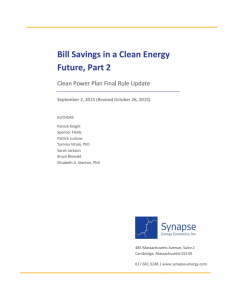Full Title: Bill Savings in a Clean Energy Future, Part 2: Clean Power Plan Final Rule Update
Author(s): Patrick Knight, Spencer Fields, Patrick Luckow, Tommy Vitolo, Sarah Jackson, Bruce Biewald, and Elizabeth A. Stanton
Publisher(s): Synapse Energy Economics, Inc
Publication Date: October 1, 2015
Full Text: Download Resource
Description (excerpt):
On August 3, 2015, the U.S. Environmental Protection Agency (EPA) released its final Clean Power Plan under Section 111(d) of the Clean Air Act. The Clean Power Plan aims to reduce emissions of carbon dioxide (CO2) from existing fossil fuel‐fired power plants by approximately 32 percent below 2005 levels by 2030. These targets are based on a conservative set of assumptions for what is technologically and economically achievable. As a point of comparison, Synapse Energy Economics, Inc. (Synapse) developed and analyzed a scenario designed primarily to push the limits of emission reductions that are available at little or no net cost to society. The “Clean Energy Future” scenario models what would happen if each state invested heavily in energy efficiency and renewable energy.
Updating our July 2015 analysis to accurately represent the final Clean Power Plan after its release confirmed our original conclusions. The Clean Energy Future pathway over-complies with the Clean Power Plan’s CO2 emission reduction targets, and has the added benefit of lowering electricity costs over the long term compared to existing practices and policies. In fact, in many states, electricity bills will actually decline from 2012 levels. Depending on the level of participation in ratepayer-funded energy efficiency programs under this scenario, 2030 bills are expected to be $35 per month lower than in a business-as-usual (“Reference”) scenario and, on average, $13 per month cheaper than residential bills were in 2012.
